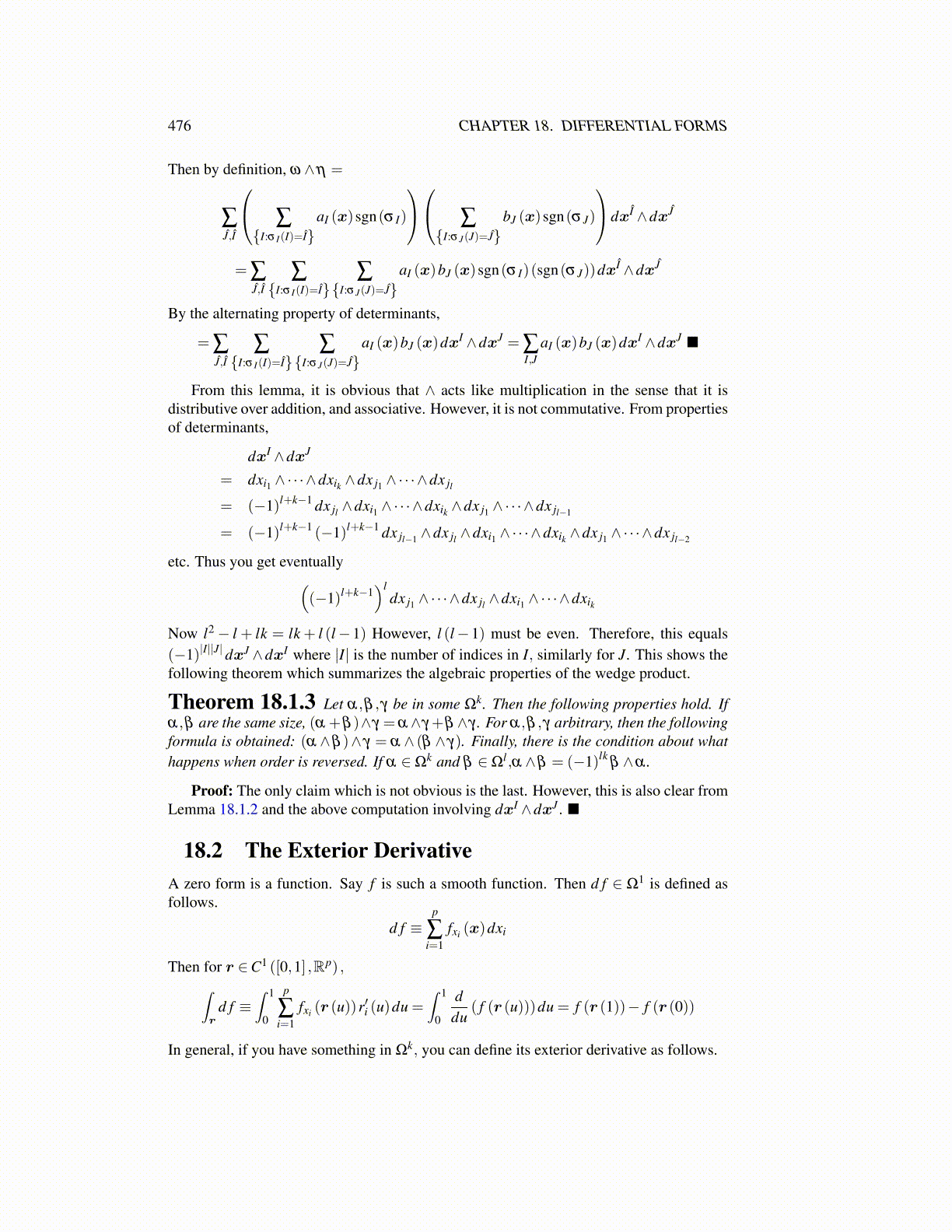
476 CHAPTER 18. DIFFERENTIAL FORMS
Then by definition, ω ∧η =
∑Ĵ,Î
∑{I:σ I(I)=Î}
aI (x)sgn(σ I)
∑{I:σ J(J)=Ĵ}
bJ (x)sgn(σ J)
dxÎ ∧dxĴ
= ∑Ĵ,Î
∑{I:σ I(I)=Î}
∑{I:σ J(J)=Ĵ}
aI (x)bJ (x)sgn(σ I)(sgn(σ J))dxÎ ∧dxĴ
By the alternating property of determinants,
= ∑Ĵ,Î
∑{I:σ I(I)=Î}
∑{I:σ J(J)=Ĵ}
aI (x)bJ (x)dxI ∧dxJ = ∑I,J
aI (x)bJ (x)dxI ∧dxJ ■
From this lemma, it is obvious that ∧ acts like multiplication in the sense that it isdistributive over addition, and associative. However, it is not commutative. From propertiesof determinants,
dxI ∧dxJ
= dxi1 ∧·· ·∧dxik ∧dx j1 ∧·· ·∧dx jl
= (−1)l+k−1 dx jl ∧dxi1 ∧·· ·∧dxik ∧dx j1 ∧·· ·∧dx jl−1
= (−1)l+k−1 (−1)l+k−1 dx jl−1 ∧dx jl ∧dxi1 ∧·· ·∧dxik ∧dx j1 ∧·· ·∧dx jl−2
etc. Thus you get eventually((−1)l+k−1
)ldx j1 ∧·· ·∧dx jl ∧dxi1 ∧·· ·∧dxik
Now l2− l + lk = lk + l (l−1) However, l (l−1) must be even. Therefore, this equals(−1)|I||J| dxJ ∧dxI where |I| is the number of indices in I, similarly for J. This shows thefollowing theorem which summarizes the algebraic properties of the wedge product.
Theorem 18.1.3 Let α,β ,γ be in some Ωk. Then the following properties hold. Ifα,β are the same size, (α +β )∧γ =α∧γ+β ∧γ . For α,β ,γ arbitrary, then the followingformula is obtained: (α ∧β )∧ γ = α ∧ (β ∧ γ). Finally, there is the condition about whathappens when order is reversed. If α ∈Ωk and β ∈Ωl ,α ∧β = (−1)lk
β ∧α .
Proof: The only claim which is not obvious is the last. However, this is also clear fromLemma 18.1.2 and the above computation involving dxI ∧dxJ . ■
18.2 The Exterior DerivativeA zero form is a function. Say f is such a smooth function. Then d f ∈ Ω1 is defined asfollows.
d f ≡p
∑i=1
fxi (x)dxi
Then for r ∈C1 ([0,1] ,Rp) ,∫r
d f ≡∫ 1
0
p
∑i=1
fxi (r (u))r′i (u)du =∫ 1
0
ddu
( f (r (u)))du = f (r (1))− f (r (0))
In general, if you have something in Ωk, you can define its exterior derivative as follows.